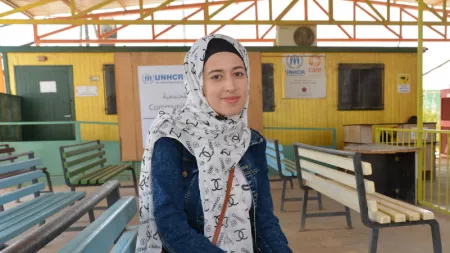Less than two hours away from the border between Jordan and Syria, in a desert area far removed from the surrounding cities, sits Al-Azraq Camp, which hosts approximately 45,000 Syrian refugees, 60% of whom are children. Balqees, an 18-year-old student whose family arrived in the camp shortly after its establishment in 2016, dreams of continuing her education outside the camp against a backdrop of limited prospects for refugee students.
Balqees spends her days studying or cooking and caring for her siblings. She dreams of studying business administration, a subject she took interest in after completing a previous course. Her father remarried after her mother passed away, leaving her responsible for the welfare of the family as the second eldest girl.
“I am the one who cooks and who is responsible for everything,”says Balqees.
Balqees shares the space that is now home – a structure made of corrugated iron sheets and insulated with plastic tarpaulin sheets – with nine other siblings. She remembers her home in Dara’a, a rural agricultural region in southern Syria where many of the camp residents come from, as a spacious house made up of four bedrooms and a living room, with an outdoor corridor that wraps around the house.
Only one scholarship is available to a student to continue their education outside of the camp. Currently there are 289 students who will sit for the standard Jordanian high-school exam in July. Balqees walks down dusty graveled roads to the IT center where she uses the shared computers to download material that she studies on her own when she is not in class. The classes start at noon and end at 6pm. The slow internet connection in the IT center is a challenge. “I wish there were more scholarships available to those who have good grades. If I don’t continue my education I will just work here at the camp,” she says.
“If there is one thing I would change, it is my place of residence so I can have access to a scholarship and better internet,”Balqees expresses in sadness.
Balqees is aware of the challenges students face: her class of high-school students in the ‘village’ or administrative division of the camp she lives in, is made up of only six girls, whereas the class dedicated to drop-out students is approximately four-times bigger in size.
CARE's response
CARE is the main service provider for community-based protection and livelihood activities in Al-Azraq camp, including psychosocial support, case management and referrals, vocational trainings, business development, community outreach and information provision, day care services, recreational activities, online learning, and higher education.
For media inquires please contact Sulafah Al-Shami, Senior Manager for Syria Response Communications, via: [email protected]
